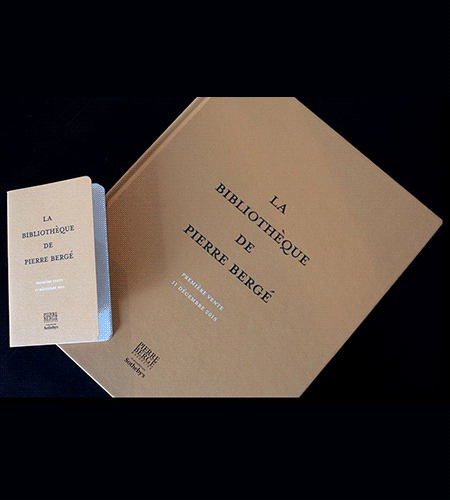The Bergé Bible – The Creation of a Monumental Catalogue
- by Thibault Ehrengardt

Exceptional sales require exceptional catalogues. On your coffee table, weighing 6 pounds, being several hundred full colour pages thick and more than 10 inches tall, here is the catalogue of the first sale of the Pierre Bergé sale!
When I wrote an article about the Pierre Bergé sale for a French website, a few weeks before it actually took place, I quoted the catalogue, and received several messages right away: “Where did you get your copy? Can you get me one? I’m looking for it.” It was not available yet, but everyone was already after it. In fact, the expert Benoit Forgeot—who put it together with Stéphane Clavreuil and Michel Scognamillo—had sent me some extracts for the article. But it took me a while before I eventually got a physical copy. That’s when I fully realized how incredible it is. Catalogues are the shop front of any sale, and an essential tool for any buyer. Not only do they detail the specificities of a book —is it complete, restored? etc.—, but they are also valuable sources of information written by experts. Yet, only a few of them go beyond their practical purpose.
This one does, as it is the result of an eight-month full-time job. “The colour itself has been meticulously chosen,” says Mr Forgeot. “There will be six sales and each catalogue will look alike except for the colour of the cover; but it shall remain a pale and discreet declension of this one. Even the colour of the sewing thread of the booklet, which goes along the catalogue, was carefully picked up.” Indeed, since a mouse may be of service to a lion, the thick folio catalogue goes along with a tiny booklet dedicated to noting down the result of each lot. This imposing beige/orange catalogue was printed at 6,000 copies. “It is not a classical catalogue,” resumes Mr Forgeot, “it was designed as the link of a global chain of communication. As such, it plays its part. It is built differently from other catalogues, and is supposed to stick in people’s mind.” For instance, apart from the somewhat expected introductions—one by Pierre Bergé himself and one by the Professor Antoine Compagnon, a part of the catalogue is dedicated to a special year: “1913 arrived suddenly, like an earthquake,” writes Pierre Bergé. “And what a seism! In the field of literature, Proust, Appolinaire, Roussel. This is the very year Marcel Duchamp, Barnum of culture, exhibited his watches at the Armory Show, in New York, then in Chicago and Boston. There were Cézanne, Matisse, Brancusi, Braque, and others.” Thus, the books linked to 1913, though not necessarily the most expensive ones are given a special treatment. They include a manuscript letter sent by Proust to Jean-Louis Vaudoyer, a copy of the first edition of Apollinaire’s Alcools—with a dedication of the author—, or George Barbier’s Designs on the Danced of Vaslav Nijinsky (London, 1913).
According to Mr Forgeot a list of underestimated books is enough to attract buyers. But the idea behind the catalogue was to seduce, and to incite people to take an active interest in the lots. As a matter of fact, not only do these descriptions give required details, but they also tell full and often fascinating stories. The punch lines alone make you want to read more: A painter, A marketer... and a Printer from Venice, in the wake of Piero Della Francesca. A literary rarity (about Leon Battista Alberti), The most brilliant treatise of the Renaissance in France: a humanist manifest (about Geoffrey Tory) or One of the jewels of the French Renaissance (about Maurice Scève), etc. Of course, the true value of this catalogue is the books it lists. But in this case, the catalogue adds value to the books. Indeed, it is helpful for the non-deeply committed bibliophilists to truly understand the historical value of Bergé’s collection. Precise and concise, the articles read like detective stories, and the various entries form a sort of historical dictionary of old books. From printers to authors to binders, meet hundreds of boiling lives and masterpieces—no wonder it looks like an in-folio Bible from the 17th century! “We wanted to publish a catalogue that would find its place on a bookshelf,” says Mr Forgeot. “The aim was to speak to the hard-core bibliophilists as well as to a larger audience.”
This catalogue is only the first part of a six-volume set. The second one will be issued for the next sale that was postponed to next November—in order to “give birth to desire again”. Curiously, it is only available in French. Pierre Bergé apparently thought it unnecessary to put out an English—or bilingual—version. The very good results of the sale probably proved him right. The only negative point about this catalogue is that it cruelly reminds us how badly we miss a serious and in-depth publication about old books featuring pictures and texts that would match the seriousness of the subject.
The catalogue is available at Pierre Bergé & Associés. 80 euros. www.pba-auctions.com.
Thibault Ehrengardt